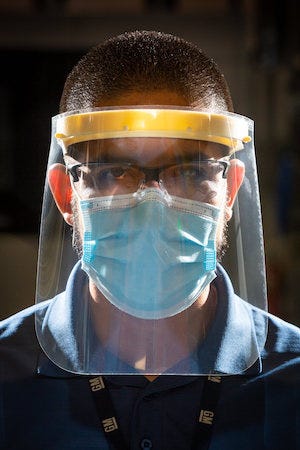GM's Pivot to Medical Manufacturing Is Powered by 3D Printing
The automaker’s institutional knowledge of additive manufacturing — it began using the technology for rapid prototyping in 1989 — helped it to pivot almost overnight to making medical devices and personal protective equipment.
July 1, 2020
![GM-ventilator-650[1].jpg GM-ventilator-650[1].jpg](https://eu-images.contentstack.com/v3/assets/blt0bbd1b20253587c0/blt395eaa2257a7da46/651416890ffb4540473b6282/GM-ventilator-6501.jpg?width=850&auto=webp&quality=95&format=jpg&disable=upscale)
General Motors has been using additive manufacturing, aka 3D printing, since 1989 for rapid prototyping. Over the years, it has broadened use of the technology and invested heavily in 3D printing equipment. Last year, it opened the 4,000-square-foot Additive Innovation Lab in Warren, MI. That breadth of expertise and institutional knowledge allowed the automaker to efficiently design the first-ever mid-engine Chevrolet Corvette — in the initial physical version of the car, 75% of the parts were 3D-printed — and to pivot in quite a remarkable fashion to making medical devices and personal protective equipment (PPE).
|
3D printers from GM's Additive Innovation Lab and Additive Industrialization Center were shipped to its Kokomo, IN, |
Earlier this year as the Trump administration scrambled to source medical equipment to avert an expected shortage as COVID-19 infections surged, President Trump invoked the Defense Production Act from the Korean War era to compel GM to sign a contract with the Health and Human Services Department. The $500-million deal contracted GM to deliver 30,000 ventilators to the Strategic National Stockpile by August.
Prior to signing this agreement, GM had been collaborating with Ventec Life Systems. The first VOCSN V+Pro critical-care ventilators produced by this partnership were delivered to medical facilities in Illinois in mid-April. “The deliveries are the culmination of a partnership between GM and Ventec Life Systems that began with a phone call exactly one month ago,” said a news release posted on the GM website on April 17, 2020. “Since then, the combined teams have sourced thousands of parts, transformed GM’s advanced electronics facility in Kokomo [Indiana] for medical device production, contracted with the U.S. Department of Health and Human Services to provide 30,000 ventilators by the end of August, and launched mass production,” said GM. “We could not have responded to the coronavirus as quickly as we did without 3D printing,” said Ron Daul, GM Director of Additive Manufacturing. “The investment in both our additive manufacturing facilities and training the team to leverage 3D printing for development has enabled us to pivot to making ventilators and personal protective equipment virtually overnight.”
To produce the medical supplies, the team applied additive manufacturing to three core areas: Manufacturing, prototyping and production, said GM.
Nearly all of the tools used to assemble the ventilators that GM is manufacturing with Ventec Life Systems and collaborator Hamilton Medical are 3D printed “nests” or fixtures that hold parts in place during assembly at GM’s facility in Kokomo as well as Hamilton Medical’s plant in Reno, NV. These nests are reverse engineered from part data received from Ventec in Seattle and Hamilton in Switzerland.
“3D printing allows us to make constant, rapid changes to fixtures based on feedback from the assembly teams,” said Dominick Lentine, GM Senior Manufacturing Engineer, Additive Applications. “We can receive feedback from Hamilton, improve a part, and have it flown back to Reno in less than 24 hours.”
|
Some of GM's 3D-printed fixtures for ventilator production are pictured. Image: Jeffrey Sauger/GM. |
To increase the speed of response even further, teams from GM’s Additive Innovation Lab and Additive Industrialization Center, both in Warren, MI, recently delivered and installed 3D printers from their respective facilities to the Kokomo plant to print new hand tools onsite.
GM’s 3D-printing expertise also contributed to the development and production of face shields for first responders. GM’s additive manufacturing team started with an open-source design that originated with desktop 3D-printer manufacturer Prusa Research. The team quickly delivered prototypes to local healthcare workers and from there, made three crucial improvements based on healthcare workers’ feedback before producing face shields in large quantities, said GM.
|
Using an open-source design, GM 3D-printed parts |
GM then 3D printed parts for more than 17,000 high-quality, comfortable face shields. In many cases, the teams printing the face-shield components were also delivering these shields to local hospitals.
Simultaneously, the team sent the final design to be mass-produced by means of injection molding. Since the final design went into full production, GM has produced more than 250,000 face shields.
More recently, GM has been 3D printing ear savers that may make protective masks more comfortable for certain wearers. As with face shield production, additive manufacturing helped GM’s team develop, refine, and distribute a design before industrializing production of the ear savers on a wider scale.
GM’s extensive use of 3D printing for medical equipment was enabled by recent investments in additive manufacturing, including two all-new facilities in Warren.
The Additive Innovation Lab opened last year in the heart of the Cole Engineering Center, inside GM’s Global Technical Center in Warren. GM employees, engineers, designers, and other team members can learn how to operate the 3D printers and software, convert files into physical parts, and then process these parts. “Most design work takes place in computer-aided design or computer-aided engineering these days, but there’s no substitute for having an actual part in hand to prove out your concept, be it a transmission component or a face shield visor,” said Quinn.
A second greenfield facility, the Additive Industrialization Center, will begin official operations in late 2020 onsite at GM’s Global Technical Center. The stand-alone facility will further expand GM’s expertise and capability in 3D printing and additive manufacturing.
About the Author(s)
You May Also Like






